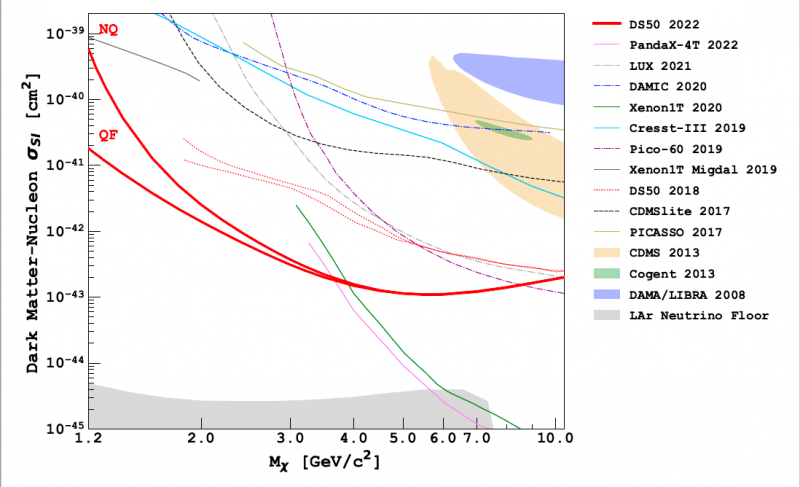
The DarkSide detector. © Collaboration Darkside
The field of direct dark matter search is experiencing a significant expansion in this decade, with many new experiments coming on board and exploring new avenues to increase sensitivity to Weakly Interacting Massive Particles (WIMPs), the leading dark matter candidate. DarkSide is a multi-stage program specifically designed to search for WIMPs with masses greater than 50 GeV, using the dual-phase liquid argon time projection chamber (TPC) technique. In such a TPC, the energy deposited by a WIMP interacting, via elastic scattering, on an argon nucleus can be detected by observing both the scintillation and ionization signals, which are converted into visible light pulses and detected by photosensors.
The APC team, involved in DarkSide since 2012, led the recent reanalysis of data acquired with DarkSide-50, a 50-kg liquid argon TPC, operated at the Gran Sasso National Laboratories from 2013 to 2019. The new analysis, aimed at searching for interactions of “light” dark matter candidates, is based on the detection of the ionization signal amplified via electroluminescence in the gas phase. Together with CPPM and LPNHE, the other French laboratories involved in DarkSide, APC provided in 2021 the first-ever calibration of the liquid argon ionization response in the sub-keV range. This allowed to lower down the DarkSide-50 analysis threshold from the nominal one at 40 keV to 4 ionization electrons, or ~0.6 keV.
The low threshold is a key element of the new analysis, which also benefited from the extended exposure, better data selection, and a more accurate background model. The analysis extended previous DarkSide-50 limits on spin independent WIMP-nucleon interactions by up to an order of magnitude, setting the world’s best limits on WIMPs with masses between 1.2 and 3.8 GeV. The limit has been extended to WIMPs with masses of a few tens of MeV by exploiting the Migdal effect, namely the emission of electrons or X-rays from the rearrangement of the argon atom after the nuclear interaction. The new analysis also set the world's best limits on WIMP-electrons interaction, axion-like particles, dark photons, and sterile neutrinos.
This result demonstrates the extraordinary discovery potential of liquid argon in the search for dark matter particle interactions, and it is also very promising in the perspective of DarkSide-20k, the detector under construction that will begin data taking in 2026 with 50 tons of active mass.
The field of direct dark matter search is experiencing a significant expansion in this decade, with many new experiments coming on board and exploring new avenues to increase sensitivity to Weakly Interacting Massive Particles (WIMPs), the leading dark matter candidate. DarkSide is a multi-stage program specifically designed to search for WIMPs with masses greater than 50 GeV, using the dual-phase liquid argon time projection chamber (TPC) technique. In such a TPC, the energy deposited by a WIMP interacting, via elastic scattering, on an argon nucleus can be detected by observing both the scintillation and ionization signals, which are converted into visible light pulses and detected by photosensors.
The APC team, involved in DarkSide since 2012, led the recent reanalysis of data acquired with DarkSide-50, a 50-kg liquid argon TPC, operated at the Gran Sasso National Laboratories from 2013 to 2019. The new analysis, aimed at searching for interactions of “light” dark matter candidates, is based on the detection of the ionization signal amplified via electroluminescence in the gas phase. Together with CPPM and LPNHE, the other French laboratories involved in DarkSide, APC provided in 2021 the first-ever calibration of the liquid argon ionization response in the sub-keV range. This allowed to lower down the DarkSide-50 analysis threshold from the nominal one at 40 keV to 4 ionization electrons, or ~0.6 keV.
The low threshold is a key element of the new analysis, which also benefited from the extended exposure, better data selection, and a more accurate background model. The analysis extended previous DarkSide-50 limits on spin independent WIMP-nucleon interactions by up to an order of magnitude, setting the world’s best limits on WIMPs with masses between 1.2 and 3.8 GeV. The limit has been extended to WIMPs with masses of a few tens of MeV by exploiting the Migdal effect, namely the emission of electrons or X-rays from the rearrangement of the argon atom after the nuclear interaction. The new analysis also set the world's best limits on WIMP-electrons interaction, axion-like particles, dark photons, and sterile neutrinos.
This result demonstrates the extraordinary discovery potential of liquid argon in the search for dark matter particle interactions, and it is also very promising in the perspective of DarkSide-20k, the detector under construction that will begin data taking in 2026 with 50 tons of active mass.
URL links:
https://arxiv.org/abs/2107.08087
https://arxiv.org/abs/2207.11966
https://arxiv.org/abs/2207.11967
https://arxiv.org/abs/2207.11968

Services/Groupes:
- Particules
